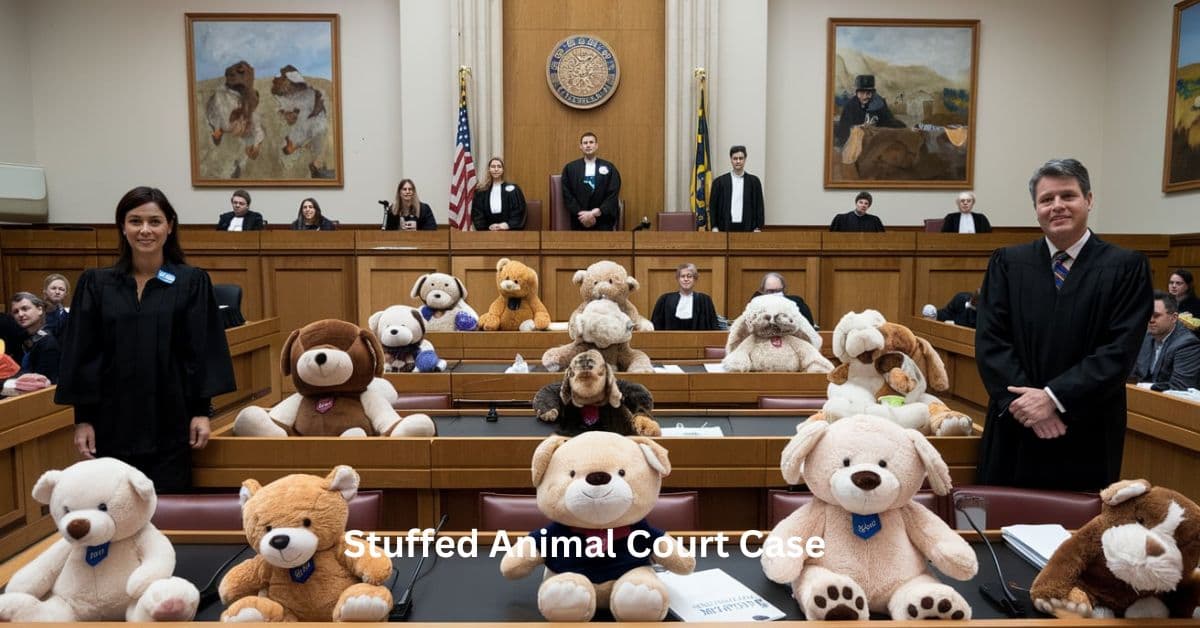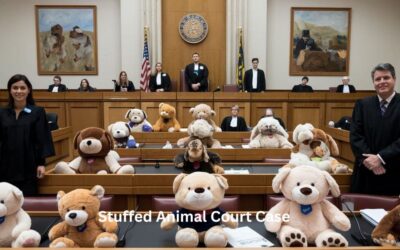Stuffed Animal Court Case: A Plush Toy Industry Showdown

The stuffed animal court case is a real-life courtroom drama that has captivated the toy industry and consumers alike. Plush toys, those beloved companions that fill the shelves of children’s bedrooms, have become the center of an intense legal battle between two toy companies. This case represents more than just a fight over fluffy toys—it symbolizes the fierce competition in the multi-billion-dollar plush toy market.
In this article, we’ll dive deep into the stuffed animal court case, explore its origins, discuss what is at stake, and provide analysis on how this case could change the toy industry. We’ll also answer some frequently asked questions to give you a better understanding of the topic.
The Origins of the Stuffed Animal Court Case
The story behind the stuffed animal court case began when two major companies in the toy industry clashed over allegations of intellectual property theft. One company accused the other of copying its plush toy designs, leading to a battle over who owns the rights to certain stuffed animal designs and features.
At the heart of the case are two well-known toy manufacturers—let’s call them Company A and Company B (the actual names are not provided here for confidentiality). Company A has been a leader in the stuffed animal market for years, known for creating unique, innovative plush toys that have gained massive popularity. Company B, on the other hand, is a newer player that has experienced rapid growth, partly due to its similarly designed stuffed animals.
The rivalry escalated when Company A accused Company B of infringing on its designs. Company A claimed that several of Company B’s plush toys were near duplicates of their best-selling products. In response, Company B argued that it had designed its toys independently and that there was no copyright violation.
Both companies have sought significant financial compensation in the form of money damages. As the legal battle unfolds, the case could lead to a precedent-setting decision about how toy designs are protected under intellectual property law.
The High Stakes of the Plush Toy Market
To understand why the stuffed animal court case is so important, it’s necessary to look at the plush toy market itself. The industry is highly competitive, with companies constantly seeking new ways to capture the hearts of children and collectors. Stuffed animals are not just toys; they are also collectibles, gifts, and even comfort items for many people.
According to industry reports, the global plush toy market was valued at approximately $10 billion in recent years. Companies are constantly innovating to create stuffed animals with new features, textures, and themes. From stuffed animals that talk to those that double as pillows, the possibilities are endless.
For Company A, which has built its reputation on unique designs, the alleged copying by Company B poses a serious threat to its business. If a competitor can successfully replicate a popular product without legal repercussions, it opens the door for others to do the same, potentially eroding Company A’s market share.
On the other hand, Company B sees itself as a legitimate player in the industry and believes that competition is healthy for innovation. It argues that no single company should have a monopoly on the concept of plush toys, and that many design elements are common across the industry.
Intellectual Property in the Toy Industry
Intellectual property (IP) law is central to the stuffed animal court case. IP law is what allows companies to protect their creations from being copied by others. In the toy industry, intellectual property comes in many forms, including copyrights, trademarks, and patents.
Copyrights are a type of intellectual property that protects original works of authorship, such as books, music, and visual designs. In this case, Company A claims that its plush toy designs are copyrighted and that Company B violated those copyrights by producing similar toys.
Trademarks protect brand names, logos, and other symbols that distinguish one company’s products from another. For example, if Company A’s stuffed animals are recognizable by a specific brand name or logo, that brand could be trademarked, making it illegal for others to use it.
Patents protect inventions, including new and useful processes, machines, and designs. While patents are less commonly applied to stuffed animals, they could potentially protect unique features or mechanisms in toys.
The stuffed animal court case brings into question how far these protections can go in an industry like toys, where certain elements—such as fluffy textures, round eyes, and soft limbs—are standard across many products. Should companies be able to claim exclusive rights to these features? Or should they be considered public domain, open to use by any company?
The Arguments from Both Sides
Company A’s Argument: Company A’s argument is straightforward: it believes that its designs are unique and have been unlawfully copied by Company B. According to Company A, these designs took years to develop and are central to the company’s brand identity. By copying the designs, Company B has not only harmed Company A financially but also undermined the creative effort that went into developing the toys.
In its legal filings, Company A has pointed to specific elements of the toys that it claims are too similar to be coincidental. These include the size, shape, and appearance of the stuffed animals, as well as the use of specific materials and color schemes. Company A is seeking a large financial settlement and wants an injunction to stop Company B from selling the disputed toys.
Company B’s Argument: Company B’s defense is that its designs are original and that there are only so many ways to make a stuffed animal. The company argues that plush toys have certain characteristics—such as soft fabric, button eyes, and simple shapes—that are standard across the industry. Company B believes that Company A is trying to monopolize common design elements that are not protected by copyright law.
Company B also argues that competition is an essential part of the toy industry. If one company can claim exclusive rights to basic design features, it could stifle creativity and innovation in the market.
Potential Impacts on the Toy Industry
The outcome of the stuffed animal court case could have significant implications for the toy industry. A ruling in favor of Company A could lead to more stringent enforcement of intellectual property rights in the plush toy market. Toy manufacturers might become more cautious about how closely their products resemble those of competitors, fearing potential legal challenges.
On the other hand, if Company B prevails, it could open the door for more competition and greater freedom in design. This could lead to a flood of new plush toys on the market, as companies feel less restricted by concerns about copyright infringement.
Innovation vs. Protection: One of the key questions at the heart of this case is how to balance innovation with protection. Intellectual property laws are designed to protect the creators of original works, but they can also limit competition if applied too broadly. In a market as creative as the toy industry, finding the right balance is crucial.
Consumer Reactions to the Case
While the stuffed animal court case is primarily a legal battle between companies, it has also attracted attention from consumers. Many people have expressed their opinions on social media, with some supporting Company A’s efforts to protect its designs and others siding with Company B’s argument that competition is healthy for the market.
Some consumers worry that if Company A wins, it could lead to higher prices for stuffed animals, as companies may have to spend more on legal fees and licensing costs. Others argue that strong intellectual property protections are necessary to ensure that companies continue to invest in creating new and innovative products.
For collectors of stuffed animals, the case could have even more significant implications. If Company A wins, it may limit the availability of certain designs, making some plush toys rarer and more valuable in the resale market.
Legal Precedents and Future Cases
The stuffed animal court case is not the first time intellectual property disputes have arisen in the toy industry. In fact, the toy industry has a long history of legal battles over copyrights, trademarks, and patents. Previous cases have involved everything from action figures to board games.
What makes this case particularly interesting is that it involves a product as seemingly simple as a stuffed animal. The outcome could set new legal precedents for how copyright law is applied to toys and other consumer products. If the court rules in favor of Company A, it could give toy companies more power to protect their designs, even if they involve standard features like fluffy ears or round eyes.
At the same time, a ruling in favor of Company B could lead to more freedom for companies to create products that are inspired by existing designs without fear of legal consequences.
FAQs About the Stuffed Animal Court Case
Q: What is the stuffed animal court case about? A: The stuffed animal court case is a legal dispute between two toy companies over allegations of copyright infringement. One company claims that the other copied its plush toy designs, leading to a battle over intellectual property rights.
Q: Why is the case important? A: The case is important because it could set a legal precedent for how intellectual property laws are applied to the toy industry, particularly in the area of plush toys. The outcome could affect how companies protect their designs and how much competition is allowed in the market.
Q: What are the potential impacts of the case? A: If the court rules in favor of the company claiming copyright infringement, it could lead to stricter enforcement of intellectual property rights in the toy industry. This might limit competition and increase prices for consumers. If the court rules in favor of the defendant, it could open the door for more competition and greater freedom in toy design.
Q: How does intellectual property law affect the toy industry? A: Intellectual property law, including copyrights, trademarks, and patents, allows toy companies to protect their creations from being copied by competitors. However, the extent to which these protections apply to toys like stuffed animals is a subject of legal debate.
Q: Could this case lead to changes in toy design? A: Yes, the outcome of the case could influence how toy companies approach design. If intellectual property protections are strengthened, companies may be more cautious about making toys that resemble those of competitors. If protections are weakened, it could lead to more creative freedom in the market.
Conclusion: The Future of Stuffed Animals in the Toy Market
The stuffed animal court case is more than just a legal dispute; it’s a battle for the future of the plush toy market. The outcome could reshape the way companies design and market their products, with potential ripple effects throughout the toy industry.
As the case unfolds, it will be interesting to see how the court balances the need for innovation with the protection of intellectual property. While both sides make compelling arguments, only time will tell how this battle will play out—and what it will mean for the future of stuffed animals everywhere.










